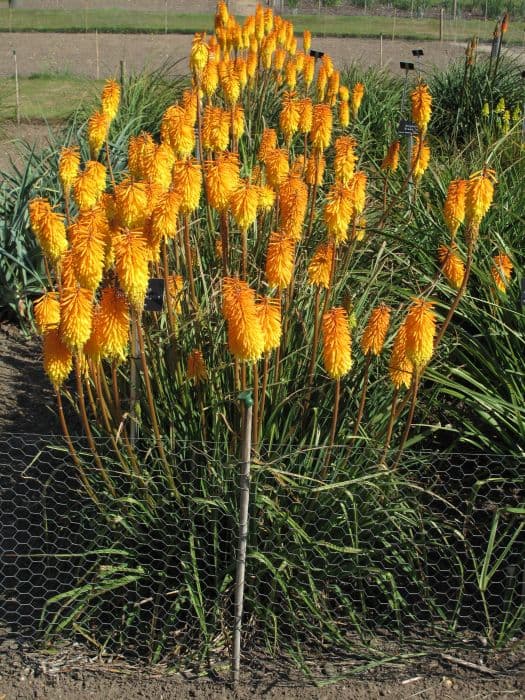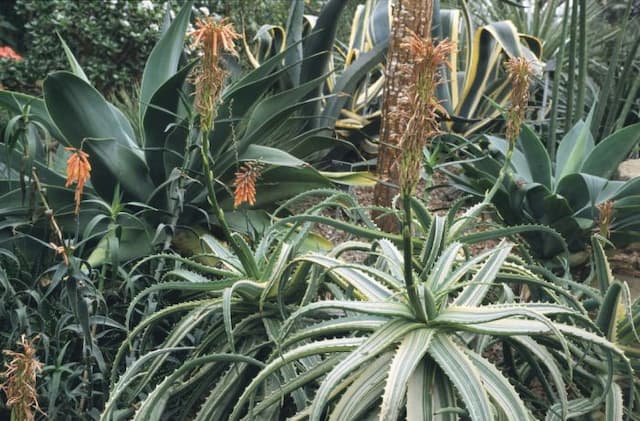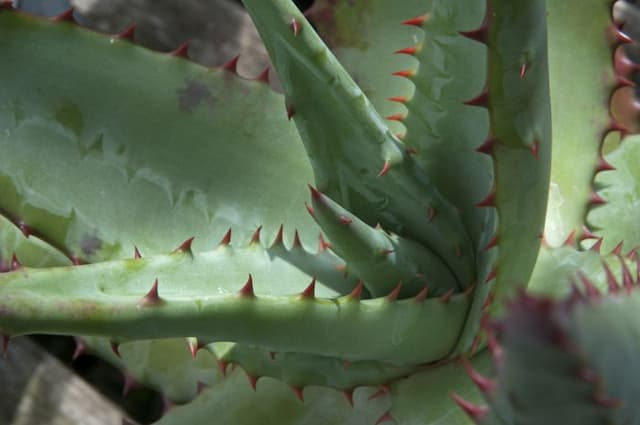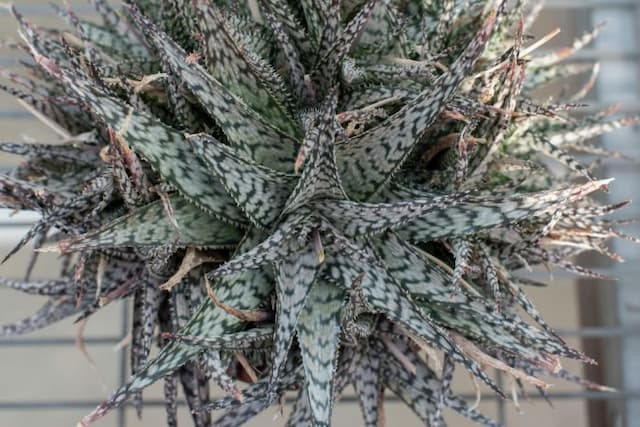Red Hot Poker Kniphofia 'Shining Sceptre' Bloom

ABOUT
Kniphofia 'Shining Sceptre' Bloom, often referred to by its common name, Red Hot Poker, is a striking perennial plant known for its vibrant flower spikes. The plant features a dense clump of grass-like, evergreen foliage, which provides a lush green backdrop to the remarkable blossoms. The flowers of the Red Hot Poker are the standout feature, characterized by their torch-like shape. They emerge on tall, sturdy stalks that rise grandly above the foliage. Vividly colored, the blooms display warm hues that include shades of yellow, orange, and fiery red, blending together as if they are emulating the glow of a sunset. The flowers progress from the bottom upwards, with the lower blossoms opening first and creating a gradient effect towards the unopened buds at the top. These cylindrical flower clusters can add a tropical flair to any garden setting. Accompanying the flowers are the pointy, blade-like leaves that are deep green in color, forming a tufted base that keeps the focus on the flowers. The Red Hot Poker's appearance can attract hummingbirds and other pollinators, adding not just beauty but also a dynamic element of wildlife to its surroundings. With its dazzling colors and stately blooms, this plant is an eye-catching addition that brings both structure and vivid color to gardens.
About this plant
 Names
NamesFamily
Asphodelaceae
Synonyms
Red Hot Poker, Torch Lily, Poker Plant
Common names
Kniphofia 'Shining Sceptre'.
 Toxicity
ToxicityTo humans
The plant commonly known as Red Hot Poker is not generally considered toxic to humans. Most members of the genus Kniphofia are not listed as poisonous, and there is no widely recognized evidence suggesting that 'Shining Sceptre' has toxic properties. However, as with any plant, individual allergies or sensitivities could occur, and it is recommended to avoid ingesting plant material that is not specifically identified as edible.
To pets
Red Hot Poker is not known to be toxic to pets. There are no specific toxins associated with it that would affect dogs, cats, or other domestic animals. However, as with any non-food plant, ingestion of large amounts of plant material could potentially cause mild stomach upset in some pets, so it is still prudent to prevent pets from consuming this plant.
 Characteristics
CharacteristicsLife cycle
Perennials
Foliage type
Evergreen
Color of leaves
Green
Flower color
Orange
Height
3-4 feet (0.91-1.22 meters)
Spread
2-3 feet (0.61-0.91 meters)
Plant type
Herb
Hardiness zones
6
Native area
Africa
Benefits
 General Benefits
General Benefits- Attracts pollinators: This plant is known for attracting bees and butterflies, which are important for pollination in the garden.
- Low maintenance: Kniphofia 'Shining Sceptre', also known as Red Hot Poker, typically requires little care once established, making it ideal for gardeners looking for minimal upkeep.
- Drought tolerance: Red Hot Poker has good drought resistance, which is beneficial for water conservation and in regions with water restrictions.
- Long blooming period: The Red Hot Poker has a long flowering season, providing color and interest in the garden over an extended period.
- Architectural interest: With its striking flower spikes and grass-like foliage, the Red Hot Poker adds structural interest to garden beds or landscapes.
- Deer resistance: This plant is generally resistant to deer, which makes it suitable for gardens in areas where deer are a common problem.
- Variety of uses: Red Hot Poker can be used in a variety of garden settings, including borders, cutting gardens, and as a focal point in landscaping designs.
- Color interest: The bright yellow to orange-red blooms of the Red Hot Poker can add a vibrant splash of color to any garden palette.
 Medical Properties
Medical PropertiesThis plant is not used for medical purposes.
 Air-purifying Qualities
Air-purifying QualitiesThis plant is not specifically known for air purifying qualities.
 Other Uses
Other Uses- Biological Pest Control: Red hot poker plants can attract beneficial insects such as hummingbird moths and bees that predate or compete with harmful garden pests.
- Dye Production: The vibrant colors of the red hot poker flowers can potentially be used to create natural dyes for fabrics or art projects.
- Educational Resource: These plants can be utilized in educational gardens to teach about pollination, plant structure, and garden wildlife interactions.
- Photographic Subject: The striking appearance of red hot poker makes it a popular subject for photographers and artists, especially when it's in full bloom.
- Garden Border: Due to its height and structure, red hot poker can be planted along the edges of gardens to create a natural, eye-catching border.
- Floral Arrangements: The long-lasting flowers can be cut and included in dry or fresh floral arrangements due to their unique shape and color.
- Mood Enhancer: The presence of bright, fiery-colored plants like red hot poker can improve the ambiance of a space, potentially enhancing mood and wellbeing.
- Thematic Landscapes: Red hot poker can be incorporated into fire-themed gardens or landscapes because of their flame-like flower spikes.
- Soil Erosion Control: The root system of red hot poker can help stabilize soil in areas prone to erosion.
- Wildlife Habitat: Red hot poker can provide shelter and nesting sites for small wildlife like lizards and beneficial insects.
Interesting Facts
 Feng Shui
Feng ShuiRed Hot Poker is not used in Feng Shui practice.
 Zodiac Sign Compitability
Zodiac Sign CompitabilityRed Hot Poker is not used in astrology practice.
 Plant Symbolism
Plant Symbolism- Attention-grabbing: The bright, fiery colors of the Red Hot Poker demand attention, making it a symbol of attracting notice and standing out in a crowd.
- Courage: Its bold hues can represent bravery and a willingness to face challenges head-on.
- Strength: The sturdy and upright growth of the Red Hot Poker is often associated with strength and resilience.
- Vibrancy: The vivid flowers symbolize a vibrant and energetic spirit or life force.
 Water
WaterRed hot poker plants like the Kniphofia 'Shining Sceptre' thrive with consistent moisture, especially during the growing season. Water deeply when the top inch of soil feels dry to the touch, approximately once a week, allowing the water to penetrate the soil deeply to encourage root growth. In hot, dry weather, you may need to water twice a week. Be careful not to overwater, as Red hot pokers are also somewhat drought-tolerant once established and dislike soggy conditions. A good rule of thumb is about 1 gallon of water per plant for each watering session.
 Light
LightRed hot pokers, including Kniphofia 'Shining Sceptre', need full sun to flourish, with a minimum of six hours of direct sunlight per day. Place Kniphofia in a spot where it won't be shaded by taller plants. These plants will bloom more prolifically and maintain healthier growth with plenty of light.
 Temperature
TemperatureRed hot pokers, such as the Kniphofia 'Shining Sceptre', are hardy and adapt well to a range of temperature conditions. They can survive temperatures as low as 10°F but perform best in areas where daytime temperatures are between 60°F and 80°F. Kniphofia plants generally prefer the warmer end of the temperature spectrum and should be protected from extreme cold.
 Pruning
PruningRed hot poker plants, such as Kniphofia 'Shining Sceptre', benefit from pruning to remove spent flower spikes and encourage reblooming. Deadheading, or cutting back the old flowers, should be done as they fade to maintain a tidy appearance. Additionally, remove any damaged or dead foliage in early spring. The best time for more extensive pruning is in late winter or early spring before new growth begins.
 Cleaning
CleaningAs needed
 Soil
SoilRed Hot Poker requires well-draining soil with a mix of loam, peat or sand components for optimal growth. A slightly acidic to neutral pH between 6.0-7.0 is ideal for Kniphofia 'Shining Sceptre' Bloom.
 Repotting
RepottingRed Hot Poker typically does not need frequent repotting; it can be done every 2-3 years or when the clump outgrows its current space.
 Humidity & Misting
Humidity & MistingThe Red Hot Poker prefers average humidity conditions and can tolerate some dryness, but does not require high humidity levels.
 Suitable locations
Suitable locationsIndoor
Provide bright light, well-draining soil, and good air circulation.
Outdoor
Plant in full sun, well-draining soil, and water moderately.
Hardiness zone
6-9 USDA
 Life cycle
Life cycleThe common name for Kniphofia 'Shining Sceptre' is Red Hot Poker or Torch Lily. The life cycle begins with seed germination, which is usually carried out in a controlled environment due to the plant's specific requirements for light, temperature, and moisture. Once the seeds have germinated and seedlings develop, they are planted in well-draining soil with full sun exposure. The juvenile plants grow vegetatively, forming a basal rosette of narrow, grass-like leaves, and over time, they establish a strong root system. As they mature, they produce tall, sturdy flower spikes topped with tubular flowers that transition from yellow-orange at the top to a rich, fiery red at the bottom, blooming predominantly in the summer. After flowering, seeds are produced if pollinators such as hummingbirds and bees have visited, completing the life cycle when these seeds are dispersed to give rise to new plants.
 Propogation
PropogationPropogation time
Spring to Summer
Kniphofia 'Shining Sceptre' Bloom, commonly known as Red Hot Poker, is often propagated through division. The best time to divide Red Hot Pokers is in the spring, just before new growth begins. Simply lift the clump from the ground using a garden fork, being careful not to damage the roots excessively. Gently separate the clump into smaller sections, ensuring that each section has at least one growth point. The divisions can then be replanted at the same depth they were originally growing, spacing them approximately 18 inches (about 46 centimeters) apart to allow for adequate growth and airflow. Water the new divisions thoroughly to help establish them, and keep the soil moist but not waterlogged as they adjust to their new location.









